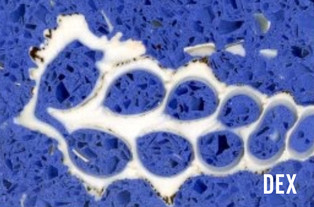

In the terrazzo world, the most commonly used shell is mother-of-pearl (MOP). Also known as Nacre, an organic-inorganic composite material produced by some mollusks as an inner shell layer. It's strong, resilient and iridescent.
Typically mother-of-pearl is crushed and loaded in the terrazzo mixer then the terrazzo mix is poured out on the floor.

Designers love the iridescent pearl appearance and the pop it brings to a terrazzo floor. There are two main sources for Mother of Pearl, Fresh Water and Salt Water. Let's take a look at the difference.

First, let's look at the Salt Water. This may also be known as Classic or Modern Mother of Pearl depending on the aggregate supplier. Salt Water MOP is more of a true gold color. It also has white and hits of black and aquamarine. When the shell is crushed you’ll notice the pieces are more shard or chunk like. Salt Water Mother of Pearl sells for over $2 per lb. The net result for adding 10% Salt Water MOP to a terrazzo mix is approx $1 per sf.


Next, let's look at the Fresh Water Mother of Pearl. This MOP is more of a rose gold in color and will pick up subtle pinks and whites. When this shell is crushed you’ll notice the pieces tend to be more flat and have rounded edges. Fresh Water Mother of Pearl sells for around $1 per lb. The net result for adding 10% MOP to a terrazzo mix is approx $.50 per sf.



Abalone is a close relative of mother-of-pearl, although in the terrazzo world it's not as commonly used. Abalone are marine snails. Their shell has a thick inner layer of the shell which is composed of Mother of Pearl. However, its highly iridescent, giving a range of strong changeable colors or more simply put colorful mother of pearl. Abalone is very expensive and sells for around $4 per lb. The net result for adding 10% Abalone is approx $4 per sf.
Other Shells
There are a host of more common shells that can be used with terrazzo. The biggest difference is that they don’t have the iridescent qualities of mother of pearl. Despite this traditional shells can add a classy beachy feel to any terrazzo floor. Some designers opt to used crushed locally sourced shells others may locate a specialty supplier to use more unique shells that are typically inlayed into the terrazzo vs crushed and mixed. Contractors will epoxy the shells to the substrate or face of the precast mold so the shell inlay is easily exposed when grinding and polishing the terrazzo.
Here is a beautiful terrazzo countertop with shell inlays from Jekyll Island Convention Center.

The designer also used a locally sourced crushed oyster shell that accounted for 30% of the terrazzo mix. Also gotta love the little water jet cut sea turtles.

Other designers have used sectional slices of drilled or spiral shells.
Fort Lauderdale Airport Terminal 3 used another locally sourced shell to bring the beachy feel to travelers as they navigate the airport.

One of our favorite installations is from the Carillon Hotel in Miami Beach. Hundreds of scallop shells were meticulously hand set prior to pouring the terrazzo floor.

We hope you’ve enjoyed learning about shells in terrazzo flooring. If you have a creative idea or would like some samples please let us know. We’d love to serve you.




